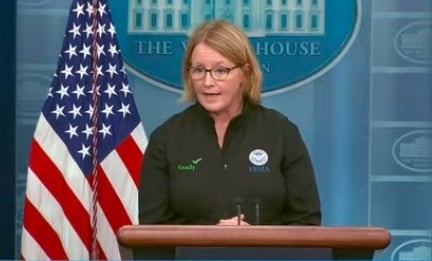During an update on Hurricane Idalia during the daily White House briefing, FEMA chief Deanne Criswell pointed to rising water temperatures for an increase in severe weather events.
Asked specifically whether she would attribute the strong hurricane, which touched down in Florida as a category 3, to climate change, Criswell replied, “I’m not going to attribute the cause of the storm, but what I can say is that we are seeing an increase in the number of severe weather events. And what we saw with this storm, as we have seen with several of our hurricanes over the last few years, is that they are intensifying more rapidly due to the elevated heat of the water temperature in the Gulf, or in the Pacific or whether it’s in the Atlantic.”
The FEMA chief added, “These storms are intensifying so fast that our local emergency management officials have less time to warn and evacuate and get people to safety. This is something that we have to take into consideration as we build our preparedness plans, or as our local communities build their preparedness plans and how they’re going to communicate and prepare these communities for the types of storms that we are going to face in the future.”
The National Hurricane Center (NHC) on Wednesday morning reported a “catastrophic storm surge occurring along the coast of the Florida Big Bend and damaging winds spreading inland over northern Florida” following landfall by Hurricane Idalia.
Sustained winds at the time of landfall—shortly before 8am ET—were estimated to be 125 miles per hour. About an hour later the storm had decreased to a very strong category 2 with 110 mile per hour winds or higher, according to the NHC.
On Tuesday as the storm was approaching the U.S., President Biden issued an emergency declaration, allowing FEMA to put necessary federal personnel and equipment in place in anticipation of landfall.
On Wednesday afternoon, Criswell said it was far too early to estimate what the cost of this storm would be, adding that officials would get a better understanding over the next several days as it becomes safer to venture out into the hurricane-hit areas.
Criswell did also note that the Big Bend section of Florida—where the peninsula merges into the state’s panhandle—had “experienced the greatest storm surge.”
The “entire footprint” of available resources, she added, is a “combined effort” recognizing the capability that the state of Florida already has, and that FEMA has “additional resources that are integrated in with that operation. So if we need to immediately augment, we have resources that are ready to deploy as soon as requested without hesitation and without interruption.”
On Tuesday, though, Criswell had stated that she’d implemented “immediate needs funding,” as FEMA’s coffers are being depleted by recent massive disasters, including the Maui wildfires, and the federal agency’s disaster relief fund which currently has a balance of just $3.4 billion.
“Congress must work with us on the supplemental request that the Administration has made on the behalf of FEMA,” she had insisted.


